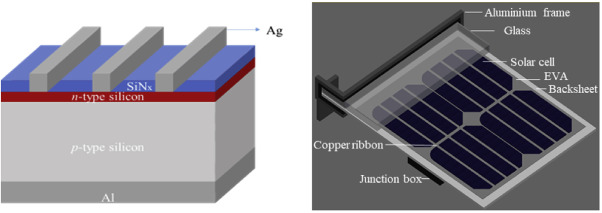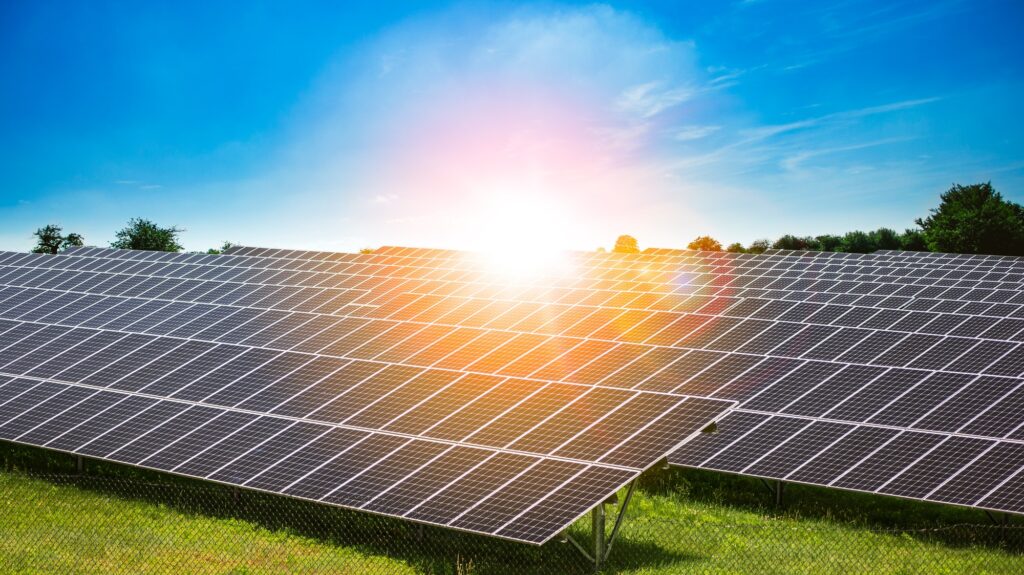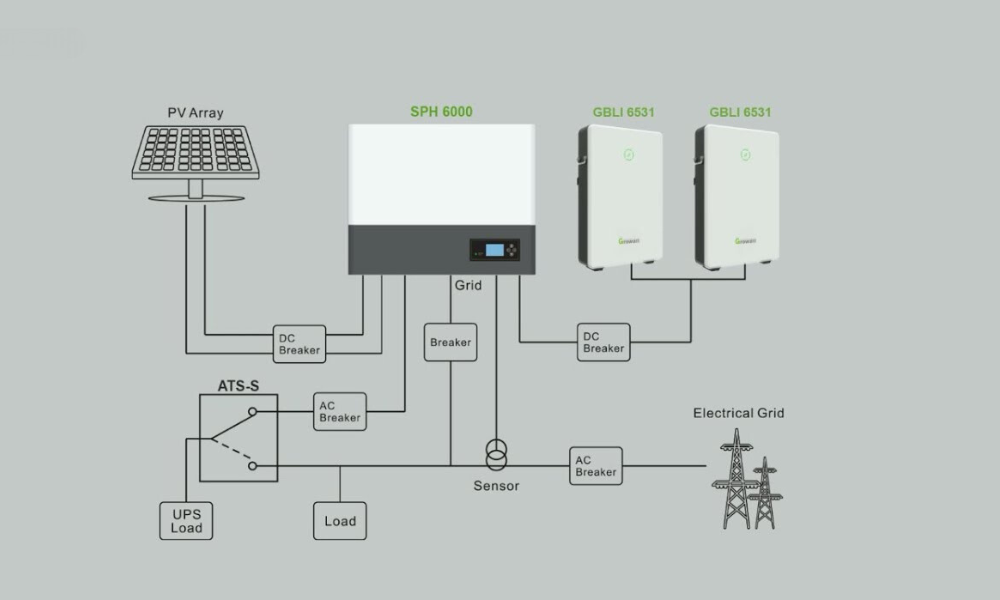As a homeowner, the rising costs of electricity and growing environmental concerns likely resonate with you. Solar energy presents a solution that addresses both these issues, offering a way to reduce utility bills and your carbon footprint. This shift towards solar power isn’t just a trend; it’s becoming a key part of sustainable living worldwide.
In this guide, we’ll dive into the essentials of solar energy for residential use. From understanding how solar panels convert sunlight into electricity, to the practical steps of installing a solar power system at home, we cover all you need to know.

A solar panel, often perceived as a singular unit, is actually a complex assembly of various components, each playing a pivotal role in converting sunlight into electrical energy. Here’s a closer look at its anatomy:
The most crucial elements of a solar panel are the solar cells, usually made of silicon. These cells are where the conversion of sunlight into electricity occurs. Each cell contains a semiconductor layer that absorbs light and generates electrical charges (electrons and holes).
Covering the solar cells is a layer of glass. This isn’t just any glass; it’s tempered for durability and often coated with anti-reflective materials. This design ensures maximum light penetration and protects the cells from environmental elements like hail or heavy rain.
Encasing the glass and cells is a sturdy frame, typically aluminum. This frame provides structural integrity, enabling the panel to withstand various weather conditions. It also facilitates easier mounting and orientation adjustments on rooftops or other structures.
The back of a solar panel features a backsheet, crucial for insulation and protection against environmental damage. It’s usually made from a durable polymer or plastic and contributes to the overall longevity of the panel.
The junction box, often unnoticed, is integral to a solar panel’s functionality. It houses the electrical connections and bypass diodes, ensuring continuous electricity flow even in partial shade conditions, and is a key component in maintaining the panel’s electrical safety.
Within the panel, electrical wiring connects each cell, forming an integrated circuit. Bypass diodes are essential for maintaining power output even when some cells are shaded, preventing the entire panel from losing efficiency.
Each component of a solar panel is meticulously designed to optimize energy conversion and durability. Understanding these components helps homeowners appreciate the sophistication behind this seemingly simple, yet incredibly effective renewable energy technology.

For homeowners exploring renewable energy options, solar power stands out for its simplicity and efficiency. At the heart of this technology are photovoltaic (PV) solar panels, which are the key to turning sunlight into electricity.
PV solar panels are made up of many solar cells, usually crafted from silicon. These cells function as the primary element in converting solar energy into electrical power. When sunlight hits a solar panel, it’s not just light that’s hitting the surface; it’s a stream of photons, or particles of solar energy. These photons carry the solar energy that we harness.
Each solar cell within a panel is designed to capture these photons. The moment a photon strikes a solar cell, it knocks electrons loose from their atoms. This process is the cornerstone of solar power generation. However, knocking electrons loose is just part of the process. The real magic happens when these free electrons are channeled in a certain direction, creating a flow of electric current.
The photons’ energy, when absorbed by the solar cells, creates an electrical imbalance within the cell. This imbalance forces electrons to flow through a circuit built into the solar panel. As they flow, these electrons generate electricity, similar to the electricity supplied by your utility company.
What makes PV solar panels particularly appealing for residential use is their ability to generate electricity without any moving parts, noise, or emissions. They silently capture sunlight and convert it into usable power. The more sunlight they receive, the more energy they produce.
Silicon is a key player in the realm of solar energy, especially for homeowners exploring this renewable power source. Its unique qualities make it the foundation of most photovoltaic solar panels.
As a semiconductor, silicon has the ability to conduct electricity under specific conditions, a vital characteristic for solar cells. Its crystalline structure, when in a pure form, is perfectly suited for managing electric charges, essential for converting solar energy.
The strength of silicon in solar technology comes from its capacity to absorb sunlight and transform it into electrical energy. When solar cells made of silicon are hit by the sun’s photons, they excite electrons, initiating an electrical flow.
To maximize efficiency, silicon in solar cells is typically combined with other elements, creating a ‘doped’ effect. This results in two distinct layers within the cell: a positive (p-type) and a negative (n-type) layer. The crucial solar energy conversion predominantly takes place at the interface of these layers, known as the ‘p-n junction.’
Upon exposure to sunlight, an electrical field is generated at this junction, driving electrons from the p-type layer to the n-type layer and thereby producing an electric current. This current, once harnessed through the panel’s wiring, is ready for household use.
Silicon solar panels are a popular choice for residential use due to their efficiency, longevity, and increasingly affordable cost. They are capable of converting a substantial portion of sunlight into electricity, providing an effective and reliable option for home solar energy systems.
Solar panels, while efficient, are not entirely free from energy loss. Several factors can diminish the effectiveness of a solar system. Understanding these factors and how to mitigate them is crucial for homeowners to ensure they get the most out of their solar investment.
By addressing these factors, homeowners can greatly enhance the efficiency and output of their solar systems, making solar energy a more valuable and sustainable investment for their homes.

Integrating solar panels into your home’s electrical system marks a significant step towards energy independence and sustainability. Understanding this integration and the electricity generation process is vital for any homeowner considering solar energy.
The inverter’s job is to convert the DC electricity from the solar panels into AC electricity. It’s a crucial component in the solar power system, ensuring the electricity generated is compatible with your home’s electrical system and appliances.
Once converted to AC, this electricity flows from the inverter to your home’s electrical panel, also known as a breaker box. This panel distributes the solar-generated electricity to your house. When your solar panels produce more electricity than you need, the excess can be fed back into the electrical grid. Many regions offer net metering, which allows homeowners to receive credits for this excess energy, further reducing their utility bills.
Most modern solar systems come with monitoring systems that allow you to track electricity production and usage. This helps in understanding your energy patterns and optimizing solar energy use.
The integration of solar panels into your home’s electrical system is a seamless process that not only powers your daily needs but also contributes to a greener planet.
When it comes to solar energy, Quebec homeowners stand at a financially advantageous juncture. The initial investment in solar panels is balanced by significant long-term benefits and incentives, particularly under the Canada Greener Homes Initiative and the Rénoclimat program.
The upfront cost of installing a solar power system includes purchasing solar panels, inverters, mounting hardware, and paying for installation. Prices vary based on system size, equipment quality, and installation complexity. Despite these initial expenses, the falling costs of solar technology have made it increasingly accessible.
The primary economic benefit of solar panels is the substantial reduction in electricity bills. By generating your own power, reliance on the grid diminishes, leading to lower monthly costs. In Quebec, this is particularly beneficial given the province’s commitment to renewable energy and sustainable living.
Under the Canada Greener Homes Initiative, co-delivered by Natural Resources Canada and the Government of Quebec through the Rénoclimat program, homeowners can receive up to 5000$ rebate for energy-efficient retrofits, including solar energy systems. These grants significantly reduce the net cost of solar installations, making them a more viable option for many. More details about these grants can be found on the Domolynx website.
Besides energy bill savings, solar panels can increase a property’s value. Homes with solar installations are often more attractive to buyers, who value the prospect of reduced energy expenses.
As we’ve explored throughout this guide, the potential of solar energy for homeowners is immense and multifaceted. From reducing electricity bills and increasing property values to contributing to environmental sustainability, solar power stands as a beacon of modern, responsible living.
The journey towards solar energy adoption is not just about harnessing a renewable resource; it’s about joining a global movement towards a cleaner, greener future. The technology has matured, costs have become more manageable, and with supportive initiatives like those in Quebec, solar power is more accessible than ever.
For those considering this transition, the importance of consulting with professional solar system providers cannot be overstated. Companies like Domolynx, with our expertise in solar system installation and knowledge of local incentives and grants, can be invaluable. They can provide tailored advice and solutions to ensure that your solar energy system meets your specific needs. To learn more about how we can assist you, visit contact page.
Embracing solar technology is not just a smart economic decision; it’s a step towards a sustainable lifestyle. The future of solar power in homes is bright, and it beckons homeowners to be a part of this exciting and rewarding journey.
Take the first step towards sustainable and efficient energy use with Domolynx. Request your free, no-obligation quote today and discover how solar energy can transform your home or business.




